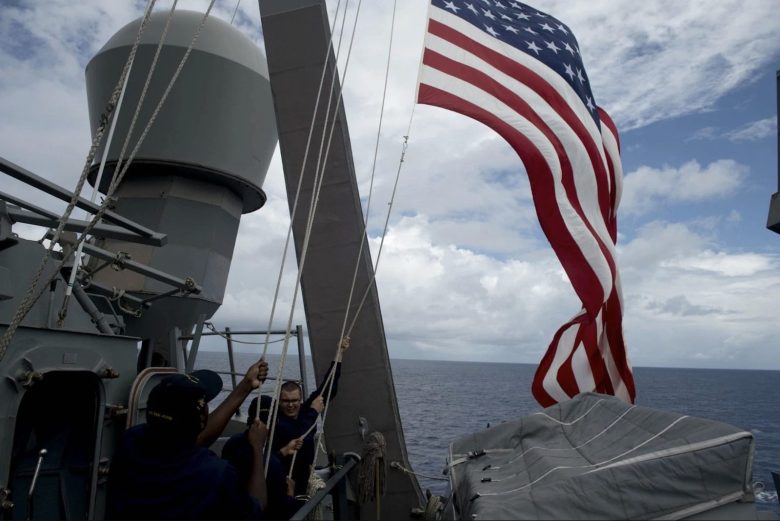The outgoing Donald Trump administration has appointed a new chief for the Pentagon’s all-crucial Indo-Pacific Command, a move that will likely consolidate its tough China policy ahead of the transition to Joe Biden early next year.
Trump loyalist and Acting Defense Secretary Christopher Miller recently appointed Admiral John Aquilino, a naval aviator and veteran of Operations Enduring Freedom and Iraqi Freedom, to head the INDOPACOM based in Pearl Harbor, Hawaii.
The new Pentagon commander is expected to oversee new rounds of reforms, including the creation of a new “expeditionary” fleet to specifically focus on China and its growing naval assertiveness in adjacent waters.
He will replace outgoing Admiral Philip Davidson, a staunch supporter of a tougher pushback against Chinese assertiveness in the Indo-Pacific.
During his tenure, Davidson oversaw a dramatic increase in the US Navy’s Freedom of Navigation Operations (FONOPs) in the South China Sea, with often multiple tours within a single month, while rapidly expanding joint exercises with like-minded powers and key allies across the region.
Under Davidson, the Pentagon also adopted new operational guidelines, including the classification of Chinese Maritime Militia Forces (MMF) as extensions of the People’s Liberation Army Navy (PLAN), marking a dramatic escalation in Washington’s efforts to constrain Beijing’s maritime ambitions.

The INDOPACOM, which played a crucial role in America’s emergence as a global power in the 20th century, boasts as many as 380,000 servicemen and is responsible for military cooperation with 36 countries spread across 14 time zones from the western shores of America all the way to East Africa.
He also oversaw growing coordination between the US Navy and the US Coast Guard, under Commander Admiral Karl Schultz, for joint efforts in preserving freedom of navigation in disputed waters as well as assisting maritime security efforts in the region, especially in Southeast Asia.
The upshot is the emergence of the INDOPACOM as the fulcrum of US strategy in Asia, the most potent expression of American power and leadership vis-a-vis the rise of China.
The incoming Biden administration has signaled its commitment to continue, improve and build on both the “pivot” to Asia strategy of the Barack Obama administration as well as the “Free and Open Indo-Pacific” doctrine of the outgoing Trump administration.
Maintaining a powerful military presence in Asia will be central to Biden’s strategy of reasserting American leadership in times of growing uncertainty vis-à-vis Washington’s wherewithal as well as Beijing’s intentions in the region.
Biden’s picks for top cabinet positions, including Secretary of State nominee Antony Blinken and frontrunner for the Secretary of Defense position Michele Flournoy, are referred to as “liberal hawks”, who favor a more muscular and coherent constrainment strategy against China relying more on coalition-building than unilateral action.
China represents a rare point of unity in a US Congress’ newly-proposed bill, representing a compromise deal between the constantly wrangling Republicans and Democrats. The 2021 National Defense Authorization Act reflects a tough anti-China bipartisan consensus, allocating $740.5 billion for defense spending, with increased focus on the INDOPACOM.

Despite an economic crisis at home, the proposed budget includes an additional $158 million for US defense spending, including $34 million for infrastructure projects, $45 million for the Army’s Multi-Domain Task Force, as well as the acquisition of strategic assets including two Columbia-class submarines and a second Virginia-class submarine which could be deployed against China in the Indo-Pacific.
The incoming INDOPACOM leadership will likely double down on recent efforts to keep China’s ambitions in check. One major proposal is an overhaul of the US’ First Fleet for expanded deployments to the South China Sea, a move that will likely reassure besieged allies such as the Philippines and strategic partners such as Vietnam, Malaysia and Indonesia about Washington’s commitment to the region.
“In order to improve our posture in the Indo-Pacific we will reconstitute the 1st Fleet, assigning it primary responsibility for the Indo and South Asian region as an expeditionary fleet,” said US Naval Secretary Kenneth Braithwaite during a recent hearing with the US Senate’s Armed Services Committee.
“This will reassure our partners and allies of our presence and commitment to this region while ensuring any potential adversary knows we are committed to global presence, to ensure rule of law and freedom of the seas,” he added.
The last time the US had such a dedicated fleet was back in 1973 at the height of the rivalry between the US and Soviet Union in Asia. The move has invoked the specter of a new Cold War, as the Pentagon seeks to transfer a growing number of its military assets and personnel to the Western Pacific and, in particular, the South China Sea.
The reorganization will likely involve transferring several warships and personnel from the 7th Fleet operating out of Japan to a yet-to-be-disclosed area. A top contender is Singapore, which boasts a large shipyard and fuelling capacities and is positioned right at the intersection of the South China Sea and Malacca Straits.

In the past decade, Singapore, nominally a neutral city-state, has become an undeclared US ally, granting permanent access to American littoral combat ships in its massive Changi port facilities.
The Philippines, a treaty ally which also boasts large-scale shipyards in Subic and Palawan, both of which are close to disputed South China Sea islands, could also play a crucial role in INDOPACOM’s reorganization, especially with Beijing-friendly President Rodrigo Duterte entering his twilight year in office.
“The 1st Fleet would be expeditionary. We are still determining from where that fleet would operate,” said US Naval Secretary Kenneth Braithwaite, leaving the decision likely to incoming INDOPACOM commander Admiral John Aquilino and the Biden administration.


